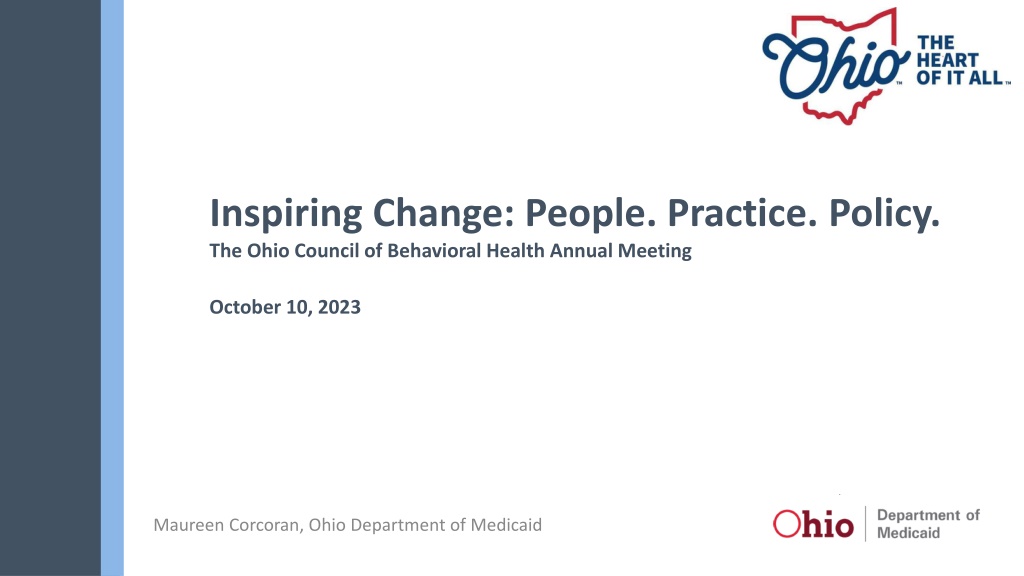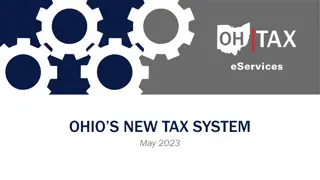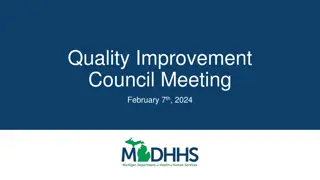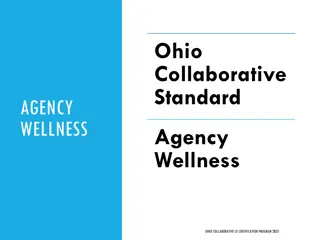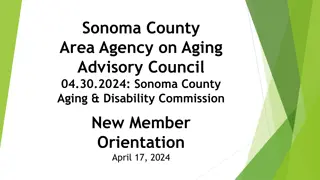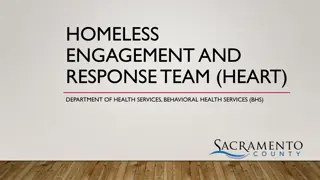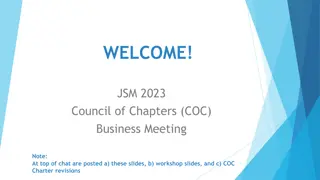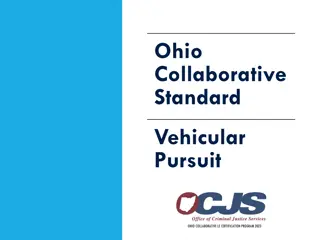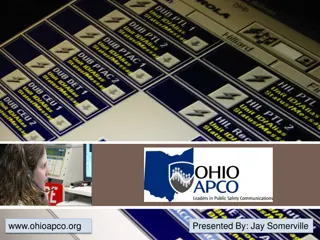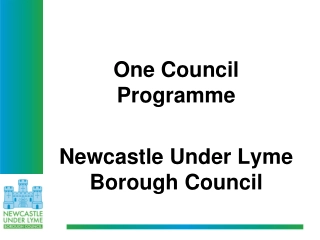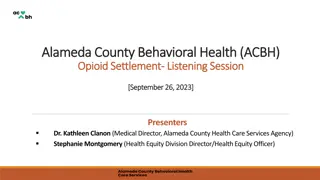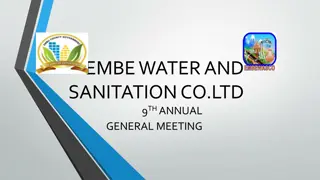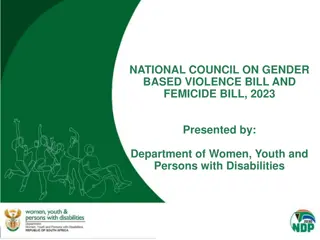Ohio Council of Behavioral Health Annual Meeting 2023 Highlights
The Ohio Council of Behavioral Health Annual Meeting in October 2023, led by Maureen Corcoran from the Ohio Department of Medicaid, focused on inspiring change through people, practice, and policy. Key topics included strategic priorities for the SFY 24-25 budget, community behavioral health updates, and ODM budget provisions. Initiatives aimed at ensuring high-quality healthcare access, addressing workforce shortages, and supporting maternal and infant health were emphasized.
Download Presentation
Please find below an Image/Link to download the presentation.
The content on the website is provided AS IS for your information and personal use only. It may not be sold, licensed, or shared on other websites without obtaining consent from the author. Download presentation by click this link. If you encounter any issues during the download, it is possible that the publisher has removed the file from their server.
Presentation Transcript
Inspiring Change: People. Practice. Policy. The Ohio Council of Behavioral Health Annual Meeting October 10, 2023 Maureen Corcoran, Ohio Department of Medicaid
The best place to live, work, raise a family, and start a business. HB 33 SFY 24-25 Budget 4
ODM Strategic Priorities for the SFY 24-25 Budget Ensuring eligible Ohioans have continuous access to high-quality health care as the state resumes routine eligibility operations. Preserving and strengthening access for Ohioans to behavioral health and other community-based services, focusing on those who provide direct care and services to individuals while working to address workforce shortages. Continued implementation of Medicaid s Next Generation of managed care, including OhioRISE, the Single Pharmacy Benefit Manager (SPBM), Fiscal Intermediary (FI), and the Provider Network Management (PNM) module. Ensuring Ohio s mothers and children have access to the necessary programming for sustainable healthcare they need, connecting pregnant mothers to evidence-based resources that improve birth outcomes, seeking to eliminate disparities that negatively impact the health of Ohioans we serve. Continuing progress on priority policy initiatives approved in HB 110 of the 134th General Assembly. 5
Community Behavioral Health: Update Target effective date January 1, 2024 State Plan | The following rate increases have been included to address the workforce pressures: We are increasing BH Services 12.75%; 10% increase for medical services in community BH agencies The BH rates clearance posting has expired but glad to continue to take feedback. We have posted the federal Medicaid notice re: SPA of our intent to raise rates. On track to original file these rules with JCARR later this month NEW Mental Health Peer Support Service Anticipate policy and rule work to be completed by April 2024; need to evaluate IT changes and timeline. Build on the OhioMHAS enhanced peer support rules to establish Medicaid policy and reimbursement. This will require clinical/programmatic work, along with reimbursement considerations. Separate funding dedicated for this service. 6
Other ODM Budget Provisions Specifications regarding training and supervision of ODM/ODA waiver personal care aides. Other rate increases of note: Emergency transportation and Dental. New department of Children and Youth. Adoption, child-care, early childhood, maternal and infant mortality. Makes continuous Medicaid coverage available for children ages 0-3 Continued implementation of ODM s Maternal and Infant Support Program (mom/baby dyad care, doulas, lactation consultants, postpartum nurse home visits) and Healthy Beginnings at Home. Expansion of Medicaid school program. Medicaid Buy-In for Workers with Disabilities > 65 years old Meaningful employment. Next Generation work collaborative - JFS/ODM. Community work orgs, MCOs. 7
ODM Budget Website HTTPS://MEDICAID.OHIO.GOV/ABOUT-US/BUDGET JULYWEBINARFORSTAKEHOLDERS H.B. 33 - HCBS SFY 24/25 BUDGET TRACKER ADDITIONALINFORE: RATES, RULES, WHITEPAPERS In Ohio, our people are our greatest asset. That is why this budget for fiscal years 2024-2025 invests in Ohioans, in our communities, and in our thriving economy. Governor Mike DeWine 8
Other Coverage Options When Individuals are No Longer Eligible If a Medicaid member has been notified they no longer qualify for Medicaid, they may be eligible for other coverage options either through their employer or on the federally facilitated marketplace (i.e., exchange). OB makes automatic file transfers through the exchange for individuals found ineligible (not individuals disenrolled for procedural reasons) ODM partnered with the Ohio Association of Foodbanks to include information on every notice of disenrollment (otherwise known as a Notice of Action) for those individuals who need assistance with other coverage options. They can visit getcoveredohio.org or call 1-888- 628-4467 for help in person, online or over the phone. 11
Resuming Routine Eligibility Operations: Appendix K Flexibilities Throughout its work on Appendix K, the State has sought to engage stakeholders at each step of the process via webinars, communications notices, public comment periods, and other channels. Learn more and find updates on the progress of ODM s Appendix K work at https://medicaid.ohio.gov/stakeh olders-and- partners/covidunwinding Subscribe to the Home- and Community-Based Waiver Programs newsletter at https://medicaid.ohio.gov/home/ govdelivery-subscribe For flexibilities that will end, the agencies will develop and communicate transition plans to ensure minimal impact on individuals. 12 12
Telehealth Appendix K Appendix K Case Management Emergency Protocol: Response to COVID-19 Allowed for required in-person assessment and visits to be performed via telehealth. Ohio Administrative Code (OAC) rules have been updated to reflect ongoing eligibility, provider certification, and service rule changes for each program. Beginning January 1, 2024, all assessments will go back to in-person CMS granted 6 months after the end of the PHE to resume normal operations and an additional month by waiver. ODM and ODA anticipate in-person visits to resume in a phased approach with the goal for all individuals to have an in-person visit/assessment completed no later than six months from the end of the Federal Public Health Emergency. Case Management Agencies will offer the assessment in-person and will accept a telehealth request through December 31, 2023. There are no other changes to telehealth services OAC 5160-1-18 last updated July 15, 2022. 13 13
Key Notes & Dates April 2023 was the first month of renewal due dates that states were permitted to begin routine eligibility determinations Ohio s ex parte (aka passive renewal) runs two months prior to due dates To date, the renewals for over 2 million recipients have been initiated. 14
Ohio thru July: Ohio experience thru September 2023 # of Individuals & % ages April May June July August September Total up for renewal 283K 316K 318K 320K 294K 298K # Retained on Medicaid 209K 232K 216K 216K 193K 195K % Retained of month total 74% 73% 68% 68% 66% 65% % People terminated 24% 23% 23% 24% 26% 24% % People ineligible 8% 7% 6% 5% 6% 5% % Procedural terminations 16% 16% 17% 19% 20% 19% Not processed by month end 2% 4% 9% 8% 8% 10% 15
Peer State Comparisons PA OH NC MI KY IN Renew ExParte Manual Renew ProcTerm Ineligible Pending 17
OHIO DEPARTMENT OF MEDICAID ELIGIBILITYPROCESS: END-TO-END EXAMPLE: JULY 2023 RENEWALS Eligibility process data highlights 1. 50% of procedural terminations were found likely ineligible Ineligible Terminations 5% Auto Ex Parte 40% 2. Approximately half of cases categorized as "prepopulated form" renewals are manual ex parte renewals conducted without a prepopulated renewal form returned Manual Ex Parte/Pre-Populated Renewal Forms 2 28% Communications IVR: automated reminder calls to members Eligible: Renewal Received Bot engaged & caseworker attempts manual ex parte ProComm: state automated reminder texts to members & updates member addresses in Ohio Benefits Procedural Terminations 1 19% 3rd party data sources reviewed Cases identified as eligible, likely eligible, likely ineligible IEVS analyzes & sorts fallout cases Likely Eligible & Likely Ineligible: Renewal Packets Sent CMA/MCO outreach to members Automations throughout eligibility process Fast Lane Bot: conducts nightly sweeps to identify any SNAP re-certifications with a corresponding Medicaid case (e14 SNAP option waiver authority) Address Bot: automates address updates received from MCEs, Automated Health Systems, and received through National Change of Address database (e14 waiver authority) in Ohio Benefits System *NOTE: the remaining 8% are cases that were not yet processed at the time of reporting
Next Gen Update & Other ODM BH Policy Population Health & Next Generation Changes Inc. changes to care coordination CPC, CPC-Kids, CMC APM & Other value based relationships (beginning Dec.23 to count for SFY24) CCBHC & associated service/coding refinements MRSS & crisis continuum 20
Ohios Next Generation Medicaid Program Mission Statement 21
Next Generation Ohio Medicaid Implementation July 1, 2022 October 1, 2022 2 1 Centralized Provider Credentialing reduces duplication, providers have more time for members. launched to help children and youth with behavioral health and multi-system needs. Single Pharmacy Benefit Manager (SPBM) statewide pharmacy access for members, statewide payment policies for pharmacies. Gradual Completion February 1, 2023 3 4 Next Generation Managed Care Plans Individualized assistance and coordination for members, focus on quality and outcomes. Final IT Systems Implementation Single point of entry for all claims and prior authorization requests. Significant IT Systems Implementation Intake and route majority of claims to appropriate managed care plans, increasing transparency and visibility regarding care and services. All data transparently available for ODM to monitor and evaluate our program. 22
Better Services for Pregnant Members and Newborns Support groups and nurse home visits for emotional and physical support during pregnancy. Free breast pump 24/7 help with breastfeeding for newborns. After-Hours Behavioral Health Crisis Services Access to anafter-hours phone number connecting individuals experiencing mental health/addiction- related challenges to a statewide crisis line. Enhanced Support for Member Transportation Improved trips to appointments and pharmacies include ambulance, wheelchair van, and other emergency transportation and county non- emergency transportation. Additional Support for Children Additional behavioral health services include therapy and substance use disorder treatment services. Next Generation Program Key Improvements Community Investment Ohio Medicaid is investing in local communities by partnering with community organizations and supporting local programs to help improve health outcomes. 24/7 Medical Advice Line Call your managed care plan s 24/7 medical advice line anytime you have a medical question or need help. OhioRISE OhioRISE is a specialized managed care program for children and youth with complex behavioral health and multisystem needs. Single Pharmacy Benefit Manager (SPBM) With Gainwell as the Next Generation s single administrator for pharmacy needs and services, members receive medications they need regardless of managed care plan. Commitment to Individual s Health and Cultural Respect We are supporting healthcare staff by providing programs and trainings that include cultural understanding and respect for everyone s experiences. Increased Accessibility If English is not your primary language or you are hard of hearing, your plan has a toll-free number and telephone services available to make sure you can easily get the information and services you need. Individualized Coordination and Care Management Access to a health navigator to help individuals find services specific to their needs. Freeing Up Providers to Better Serve You Ohio Medicaid has implemented changes to ease the administrative burden on providers, so they have more time to focus on you. Focus on Preventive Care and Wellness Members have an opportunity to receive rewards for wellness visits, vaccinations, and preventative care screenings for illnesses including diabetes. Telehealth Services To ensure you can receive care even when you can t make it to the doctor s office, telehealth appointments are available for healthcare needs.
Ohio Medicaids Next Generation Managed Care Entities (MCE) Serving Members since February 1, 2023 Serving Members since 2022 CareSource Ohio, Inc. AmeriHealth Caritas Ohio, Inc. Buckeye Health Plan Since July 1, 2022 Humana Healthy Horizons in Ohio Single Pharmacy Benefit Manager (SPBM) Molina Healthcare of Ohio, Inc. Anthem Blue Cross and Blue Shield Gainwell Technologies United Healthcare Community Plan of Ohio, Inc. Since October 1, 2022 24
1 2 3 Next Generation Managed Care Plan Provider Impacts Managed Care Contracts Contracts with the MCOs have been updated to ensure consistency and minimize differences between how providers interact with the Next Generation managed care plans. Managed Care Plan Portal Continue using managed care plan portals for direct data entry of claims submission and prior authorizations (PA). All managed care PAs are submitted directly to MCO. Next Generation Managed Care Plans Seven Next Generation managed care organizations (MCO) began providing services to Ohio Medicaid members. 4 5 6 7 Member ID Number For managed care claims submitted to a trading partner the Medicaid ID (or MMIS ID) must be the ID number used for claims processing. Providers can check member eligibility and member IDs via the Provider Network Management (PNM) module, which redirects to MITS. External Medical Review An external medical review is offered to providers who are unsatisfied with an MCO s, including the OhioRISE plan, decision to deny, limit, reduce, suspend, or terminate a covered service for lack of medical necessity. Electronic Data Interchange (EDI) Providers should confirm their trading partner is authorized to work with Deloitte, the new EDI vendor. EDI claims are submitted to the new EDI vendor. PAs will not be submitted to the new EDI. Rendering Provider EDI-submitted claims must only include one rendering provider. Different rendering providers at the detail level are no longer acceptable. *Exceptions for FFS Federally Qualified Health Centers (FQHC) and Rural Health Clinics (RHC) providers are detailed https://medicaid.ohio.gov/static/About+Us/PoliciesGuidelines/MAL/MAL622-A.pdf 25
OhioRISE 26
One-pager Press Release On July 1, 2022, Governor Mike DeWine announced the Ohio Department of Medicaid s launch of OhioRISE (Resilience through Integrated Systems and Excellence), Ohio s first-ever highly specialized behavioral health program for children and youth with the most complex behavioral health needs who are served by Medicaid. OhioRISE Launch Updates Resources for Members and Families Resources for Community Partners and Providers 27
Summary of OhioRISE Objectives Improve design, delivery, and timeliness of care coordination and supports kids need to thrive Prevent custody relinquishment and better serve multisystem youth Add more intensive in-home and community-based services and supports Family and youth are at the center, with voice and choice prioritized Stakeholder engagement, transparency, and accountability Shared governance model 28
Ohio Medicaid Enterprise System (OMES) Single Pharmacy Benefit Manager (SPBM) Electronic Data Interchange (EDI)/ Fiscal Intermediary (FI) Provider Network Management (PNM) 30
Ohio Medicaid Enterprise System (OMES) Once complete, how does OMES benefit Ohio Medicaid providers? Creates a single credentialing process through the Provider Network Module and Centralized Credentialing, rather than providers credentialing separately for each managed care entity (MCE) with which they contract. Provides pharmacy services across all MCEs and members through the Single Pharmacy Benefit Manager (SPBM). How is OMES related to the Next Generation of Ohio Medicaid? OMES provides new modules for conducting business and streamlines processes. Minimizes missing claims, delays in claims submission, and delayed payments. Makes the claims, prior authorization, and member eligibility request process more transparent and efficient by limiting submission and communication of status to one single portal regardless of the MCE involved. Paper submissions, fax, and/or submissions to multiple MCE portals are no longer allowed. Enables increased ODM oversight of MCEs and ability to identify and address trends by providing ODM with consistent access to claims and prior authorization request data. 32
Top things Providers need to know for EDI claims* Claims with dates of service on or after February 1 must be submitted through the new EDI vendor, Deloitte. Claims with dates of service prior to February 1 can be submitted via the current processes or the new EDI. Separate files must be submitted using the receiver ID assigned by ODM for each plan. (e.g., CareSource Payer file can only contain claims for members covered by CareSource) 1 5 Claims must include the internal managed care payer ID listed in the ODM Companion guides so the managed care entity (MCE) can route claims appropriately within their own systems. Billing providers must be enrolled with ODM as a provider type who is permitted to be a billing provider and be paid for services. 2 6 Different rendering providers at the detail level are no longer acceptable for FFS and managed care claims. Claims must only include one rendering provider at the header level per claim for FFS and managed care members. The rendering provider must not be included at the detail level.** Non-billing provider types must be affiliated with the billing provider on the claim. Claims without appropriate affiliation will be rejected on the 824 transaction. 7 3 Must use the 12-digit ODM assigned Medicaid member ID even if an MCE is the destination payer. Upon claim submission EDI will validate code sets. Claims with invalid codes will be rejected with the -999 transaction. 4 8 Only ODM authorized Trading Partners will be permitted to exchange EDI transactions. Companion Guides which will be used for both managed care and FFS can be found at https://medicaid.ohio.gov/resources-for- providers/billing/trading-partners/companion-guides/companion-guides. *Providers continue to submit MyCare claims and prior authorizations to the MyCare managed care plans. **Exceptions for FFS Federally Qualified Health Centers (FQHC) and Rural Health Clinics (RHC) providers are detailed https://medicaid.ohio.gov/static/About+Us/PoliciesGuidelines/MAL/MAL622-A.pdf 33
For EDI-submitted claims, what is the role of FI? Providers and administrators do not directly access the FI The FI does the following: Replaces the following MITS claims and financial subsystems: Processing of fee-for-service (FFS) claims Replaces the following OAKS functionality: Payment of FFS providers Electronic funds transfer (EFT) bank account information changes must be made in the PNM All other payments as directed by the state (Comprehensive Primary Care, Hospital Care Assurance Program) New clearinghouse functionality: ODM has worked with the MCEs in terms of data sharing for PAs and claims that won t be submitted to the OMES front door. 34
Functions of the FI Disperse payment of per member per month capitation rates to MCOs (includes rate management) Route managed care claims submitted via EDI, enabling monitoring of claims timeliness. Receipt and validation of encounters received from managed care organizations (MCOs) resulting from their claims processing. Disperse other payments as directed by the state. Manage financial data for Medicaid and related programs operated by OMES, enabling greater transparency and accountability Exchange data with MCOs. 35
Single Pharmacy Benefit Manager (SPBM) The SPBM is a specialized managed care organization contracted with ODM to administer Ohio Medicaid s prescription drug program. The Next Generation of Managed Care ODM and stakeholders identified problems such as pricing, rebates, claw backs, fees, formulary, inaccessible data, contract steering, access to rural pharmacies, and dispensing fees, shaping the SPBM. By directly contracting with ODM, the SPBM provides ODM greater ability to monitor quality, transparency and accountability in the pharmacy program. OHIO MEDICAID ODM SPBM WHO IS RESPONSIBLE? MCO PPAC Pharmacy reimbursement and benefit design Pharmacy benefits manager oversight and auditing Pharmacy network management (retail and specialty) Unbundling core functions of the pharmacy benefit allows ODM to identify and eliminate potential conflicts of interest. Prescriber (physician) provider services Pharmacy provider services With timely, consistent information to each of the MCOs, quality care is provided to all Medicaid members. Member services Utilization management Claims adjudication and payment Systems and technology Data warehouse, analytics and reporting Unified preferred drug list (UPDL) Federal and state supplemental drug rebate processing Clinical programs (MTM, care coordination, etc.) The SPBM increases data accuracy and timeliness, supporting program integrity, quality, and pay-for-performance initiatives. Previously responsible Responsible in Next Generation program
Ohio Medicaid SPBM: Greater Accountability and Transparency The single pharmacy benefit manager (SPBM) partners with Ohio Department of Medicaid (ODM) to improve management and administration of pharmacy benefits for our members. This helps provide quality care for our members, transparency in operations, and responsible stewardship of Ohio taxpayer dollars. SPBM contracts directly with ODM. ODMrequires predictable and fair pharmacy reimbursementsand networks. ODMhas the tools to ensure the managed care pharmacy benefit is aligned to support integration with clinical services and provides true transparency. New structurehas checksand balances in placeto prevent conflictsofinterest. 37
PPAC Functions SPBM Functions Support New Pharmacy Model The PPAC provides services to ODM to support the new pharmacy business model by: Eliminating the information black box between ODM and current MCOs and their PBMs. Providing consultation services to explore best practices. Single Pharmacy Benefit Manager The SPBM consolidated the processing of retail pharmacy benefits and maintains a pharmacy claims system that integrates with the Ohio Medicaid Enterprise System (OMES), MCOs including Aetna, the OhioRISE plan, pharmacies, and prescribers. Managed Care Pharmacy Reimbursement and Benefit Design The PPAC supports pharmacy reimbursement and benefit design by: Conducting Ohio Average Acquisition Cost (OAAC) surveys to develop a fair and transparent pricing model. Assisting in development of value-based dispensing fees. Member Access to Medications The SPBM works to provide: More pharmacy choices. Fewer out-of-network* restrictions. Consistent pharmacy benefits for all managed care members. Improved Pharmacist and Prescriber Processes Pharmacists and prescribers see benefits from the SPBM model: Streamlined processes. Only need to work with one PBM rather than multiple contracted PBMs. Streamline inventory based on a consistent and transparent preferred drug list. Pharmacy Program Oversight and Auditing The PPAC provides oversight by: Prohibiting any steering to related pharmacies by the SPBM. Supporting ODM by conducting audits of the SPBM Ensuring the SPBM does not receive unallowable rebates, refunds, clawbacks, or payments. *Network considerations are only for managed care members. 38
Recent changes and Updates related to PNM PNM Administrator transfer new ODM 10304. This form should be used when a practitioner moves to a different Medicaid provider and a new PNM Administrator needs to be assigned to their individual Medicaid ID to ongoing management of their provider data in the PNM. PNM Enrollment Agent Role: Edit Key Provider Identifiers, this change increases the ability of the Enrollment Agent role to update some additional demographic information. Provider Enrollment Processing Average turnaround time: Credentialing Review and Completion Average turnaround time: 15 - 20 business days 8 - 9 business days 39
PNM and Centralized Credentialing Updates Public health emergency (PHE) Return to Routine Provider revalidations resuming October 2023 In-person site visits resuming for organizational providers August 2023 For independently licensed practitioners, revalidation and recredential dates are paired Revalidations Recredentialing Federal Requirement 5-year provider agreement All providers subject to this including those that are under delegate agreement. National Committee for Quality Assurance (NCQA) Requirement 3-year recredentialing requirement Only Independently Licensed Practitioners are subject to NCQA credentialing/recredentialing. 40
PNM Provider Master File The PMF includes all providers screened and enrolled with Ohio Medicaid. It also includes address and demographic information, provider affiliations, specialties and effective dates. ODM also sends a daily Credentialing File to include all the practice information, and other information necessary for provider directories. ODM sends a daily Provider Master File (PMF) to all the MCEs. To learn more about ODM credentialing requirements, refer to OAC rule 5160-1-42 41
Accessing Provider Network Management Resources PNM Module Adding a Hospital Affiliation Revalidation Affiliations Updating or Adding Practice Locations Converting ORP to Standard (FFS) Self-Service Functions 3. Select the resource you are needing. Listed above are some of the most popular resources available to providers regarding the PNM module. 1. Navigate to the Provider Network Management (PNM) Module. 2. Click on the Learning button in the top navigation bar. Access the Provider Network Management module at https://ohpnm.omes.maximus.com/OH_PNM_PROD 43
Who can providers reach out to if they need help? Help Desk Who Should Call? Types of Issues/Questions Supported ODM Integrated Helpdesk (IHD) 800-686-1516 or IHD@medicaid.ohio.gov Provider representatives are available Monday - Friday 8 a.m.-4:30 p.m. Interactive Voice Response System (IVR) provides 24/7/365 access to information regarding client eligibility, claim and payment status, and provider information. Current Ohio Medicaid providers/prescribers Current OhioRISE providers/prescribers Providers interested in enrolling with Ohio Medicaid OMES submitted claims, prior authorization, and other administrative tasks General Medicaid member eligibility questions General Medicaid payment/billing questions and issues Enrolling as an Ohio Medicaid provider Provider Network Management (PNM) module OH|ID or portal password support Centralized credentialing Using the CANS assessment tool and CANS IT system Managed Care Entity (MCE) Provider Hotlines (includes Aetna OhioRISE plan) Contact information and hours vary by MCE, information is available on page 2. Current Ohio Medicaid providers contracted with the MCE Providers interested in contracting with the MCE Providers with questions about claims, billing MCE member claims, payment/billing questions and issues MCE prior authorization for a member with the MCE Verifying a member s MCE eligibility Contracting with the MCE Gainwell Single Pharmacy Benefit Manager (SPBM) Customer Support Center 833-491-0344 or OH_MCD_PBM@GainwellTechnologies.com 24 hours a day, 7 days a week Gainwell-contracted pharmacists and pharmacy staff Current Ohio Medicaid providers/prescribers Current OhioRISE providers/prescribers Assistance or issues with pharmacy claims, prior authorizations, and/or other administrative pharmacy tasks Information about Ohio Medicaid s SPBM and pharmacy program 44
Who can providers reach out to if they need help? Continued. General Provider Inquiry Phone Number General Provider Inquiry Email Provider Contracting Phone Number Manage Care Entity Web Portal Provider Contracting Email AmeriHealth Caritas Ohio, Inc. ProviderRecruitmentOH@amerihe althcaritas.com OhioProviderServices@amerihe althcaritasoh.com https://navinet.navimedix.com/ plan-central/acoh 1-833-644-6001 1-833-296-2259 Anthem Blue Cross and Blue Shield OhioMedicaidProvider@anthem .com https://apps.availity.com/availit y/web/public.elegant.login OhioMedicaidProvider@anthem.co m 1-844-912-1226 1-800-462-3589 https://www.buckeyehealthplan .com/login.html Buckeye Health Plan 1-866-296-8731 N/A 1-866-246-4358 OHNegotiators@CENTENE.COM CustomerAdvocacyCommunicati on@CareSource.com https://providerportal.caresourc e.com/GL/SelectPlan.aspx Ohio_Provider_Contracting@cares ource.com CareSource Ohio, Inc. 1-800-488-0134 1-800-488-0134 Humana Healthy Horizons in Ohio ohionetworkspecialist@humana.co m 1-877-856-5707 N/A https://www.availity.com 1-877-856-5707 Molina Healthcare of Ohio, Inc. https://provider.molinahealthca re.com OHContractRequests@MolinaHealt hCare.com 1-855-322-4079 N/A 1-855-322-4079 UnitedHealthcare Community Plan of Ohio, Inc. 1-800-600-9007 ODMEDI_HELPDESK@uhc.com https://www.uhcprovider.com 1- 800-600-9007 Governmentaffairsohio@uhc.com Aetna Better Health of Ohio https://apps.availity.com/availit y/web/public.elegant.login 1-833-711-0773 OHRISE-Network@aetna.com 1-855-364-0974 OHRISE-Network@aetna.com 45
Other ODM BH Policy Workforce MyCare MRSS & crisis continuum SUD waiver and residential/treatment continuum TT-TC and developing policy re: those incarcerated 47
MyCare 48
MyCare Conversion Charter and Principles Moving to the Next Generation of Managed Care for Individuals Dually Eligible for Medicare and Medicaid Threshold Decisions Ohio Submitted Plan for the Next Generation of MyCare as a managed care program 9/30/2022 Build on the Next Generation platform Use a similar stakeholder input process as Medicaid Next Gen Address four federally required elements of the plan:
Required elements of the Conversion Plan 1. Conduct a stakeholder engagement process 2. Maximize integration attained through MyCare and convert to integrated D SNPs, aligning with the Next Generation managed care requirements. 3. Sustain dedicated ombudsman support without federal grant funding. 4. Specific policy and/ or operational steps required for the conversion. *With the submissionof a 10/1/23 plan, Ohio has untilno later than 12/31/2025 to transition 5
